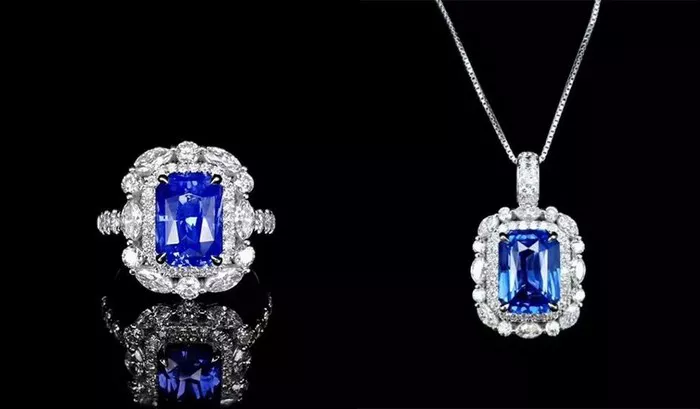Choosing the right gemstone can be a daunting task, especially with the variety of options available today. Two popular choices for engagement rings and other fine jewelry are Moissanite and White Sapphire. Both stones offer unique properties and aesthetic appeal, making them favored alternatives to diamonds. This article will delve into the characteristics, benefits, and differences between Moissanite and White Sapphire, helping you make an informed decision.
Origins and Composition
Moissanite: A Stellar Beginning
Moissanite, originally discovered in a meteor crater by French scientist Henri Moissan in 1893, is a naturally occurring silicon carbide. Due to its rarity in nature, most Moissanite available today is lab-created. This synthetic process ensures high quality and uniformity, making Moissanite an ethical and sustainable choice for gemstone lovers.
White Sapphire: A Timeless Classic
White Sapphire, a variety of corundum, is a naturally occurring gemstone. Sapphires are typically blue, but the absence of trace elements like iron and titanium results in colorless or white sapphires. Found in countries like Sri Lanka, Madagascar, and Myanmar, White Sapphires have been used in jewelry for centuries, prized for their durability and beauty.
Physical Properties
Hardness and Durability
One of the key factors to consider when choosing a gemstone is its hardness, which determines its resistance to scratches and wear.
Moissanite: Boasting a hardness of 9.25 on the Mohs scale, Moissanite is extremely durable and suitable for everyday wear. Its toughness also makes it resistant to chipping and breaking.
White Sapphire: Slightly less hard than Moissanite, White Sapphire scores a 9 on the Mohs scale. While still very durable, it is more prone to scratches over time compared to Moissanite.
Brilliance and Fire
Brilliance refers to the sparkle produced by light reflection, while fire refers to the dispersion of light into various colors.
Moissanite: Known for its exceptional brilliance and fire, Moissanite exhibits more sparkle than any other gemstone, including diamonds. This intense sparkle is due to its high refractive index (2.65) and strong dispersion.
White Sapphire: With a lower refractive index (1.76-1.77), White Sapphire does not exhibit the same level of brilliance and fire as Moissanite. It offers a more subdued and classic sparkle, often preferred by those who favor a less flashy appearance.
See Also: Tanzanite vs Sapphire
Visual Appeal
Color and Clarity
Both Moissanite and White Sapphire are prized for their colorless appearance, but there are subtle differences.
Moissanite: Typically, Moissanite is nearly colorless, but some stones may exhibit a faint yellow or gray tint under certain lighting conditions. High-quality Moissanite stones are graded on a color scale similar to diamonds, with the best being colorless (D-E-F grades).
White Sapphire: Naturally occurring White Sapphires can sometimes have a milky or cloudy appearance due to inclusions. High-quality White Sapphires are generally eye-clean and colorless, but perfect clarity is rarer than in Moissanite.
Cut and Shape
Both gemstones are available in various cuts and shapes, allowing for customization based on personal preference.
Moissanite: Due to its lab-created nature, Moissanite can be cut into precise shapes and sizes with excellent symmetry. Popular cuts include round, oval, cushion, and princess.
White Sapphire: White Sapphires can also be found in a variety of cuts, though achieving the same level of precision as Moissanite can be more challenging due to natural inclusions. Common cuts include round, oval, and emerald.
Cost and Value
Price Comparison
While both gemstones are more affordable than diamonds, there are cost differences between Moissanite and White Sapphire.
Moissanite: Generally more expensive than White Sapphire, Moissanite’s price is influenced by its exceptional brilliance and durability. However, it remains a cost-effective alternative to diamonds, offering significant savings.
White Sapphire: Often less expensive than Moissanite, White Sapphire provides an affordable option for those seeking a natural gemstone. The price can vary based on the stone’s quality and size, but it is typically lower than that of Moissanite.
Value Over Time
Moissanite: Known for retaining its brilliance and appearance over time, Moissanite is a valuable investment for those seeking long-term beauty and durability.
White Sapphire: While durable, White Sapphire may show signs of wear and scratches over time, potentially impacting its long-term value. However, it remains a timeless and elegant choice for many.
Ethical and Environmental Considerations
Sustainability
Both Moissanite and White Sapphire offer ethical and sustainable options for environmentally conscious consumers.
Moissanite: Lab-created Moissanite is produced with minimal environmental impact, making it an eco-friendly choice. The controlled production process ensures that no harmful mining practices are involved.
White Sapphire: Natural White Sapphires are mined, which can have environmental and ethical implications. However, many suppliers now adhere to ethical mining practices, ensuring minimal environmental impact and fair labor conditions.
Personal Preference and Style
Choosing between Moissanite and White Sapphire ultimately comes down to personal preference and style.
Moissanite: Ideal for those who desire maximum sparkle and brilliance, Moissanite offers a modern and eye-catching appearance. Its lab-created origin also appeals to those seeking sustainable and ethical options.
White Sapphire: Favored by those who appreciate a classic and understated look, White Sapphire provides timeless elegance. Its natural origin and affordability make it a popular choice for traditionalists and budget-conscious buyers.
Conclusion
Both Moissanite and White Sapphire are excellent alternatives to diamonds, each offering unique benefits. Moissanite stands out for its unparalleled brilliance, durability, and ethical production, making it a top choice for those seeking a dazzling and sustainable gemstone. On the other hand, White Sapphire offers classic beauty, affordability, and a natural origin, appealing to those who prefer a more traditional and understated look.
When choosing between Moissanite and White Sapphire, consider factors such as durability, brilliance, cost, and personal style. By understanding the differences and advantages of each gemstone, you can make an informed decision that aligns with your preferences and values.
Whether you opt for the fiery sparkle of Moissanite or the timeless elegance of White Sapphire, both gemstones promise to add beauty and charm to any piece of jewelry, making your selection a treasured and meaningful choice.


